Cribs are an essential part of early childhood for babies and toddlers as they’re supposed to keep your child safe and comfortable during sleep.
But how can you know that your child is safe in his bed if you don’t know how much weight can a crib hold?
A crib can support up to 50 pounds, which is more than enough for the first two years of your child’s life.
However, there are other guidelines and regulations that you need to follow, which we’ll get into later in the article.
It doesn’t matter whether you buy your crib from Amazon, Ikea, or any other online or offline retailer, the general guidelines are the same for all brands and models of standard-sized cribs.
So read on to find out everything you need to answer the question: “How much weight can a crib hold?” and also how to choose the right crib for your child.
How Much Weight Can A Crib Hold?
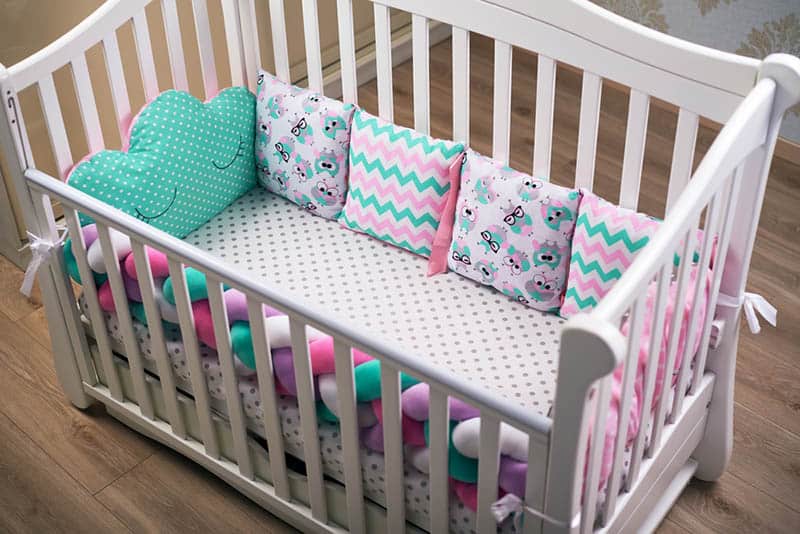
Have you ever wondered how much weight can a crib hold?
To be honest, I never gave it much thought, mostly because my children couldn’t wait to get out of their cribs and I usually paid attention only to crib height and the length of the mattress.
Nevertheless, cribs (and toddler beds) actually do have a maximum weight limit of 50 pounds.
That might not make much sense at first, especially because a typical crib weighs somewhere around 40 pounds.
However, the weight of the crib itself has little to do with its weight limit, according to manufacturers.
The weight limit doesn’t actually mean that the crib or toddler bed can’t hold more than 50 pounds, it’s just the maximum weight the crib will be exposed to.
Essentially, the majority of young children (babies and toddlers) don’t weigh over 50 pounds, which is why manufacturers don’t see the point of testing cribs for a heavier weight.
There’s a perfectly good reason for not testing heavier weights on a baby’s crib; as the name says, it’s a baby’s crib, which is why it shouldn’t contain anything else but the mattress and a baby/toddler.
This is exactly why manufacturers don’t recommend anything above the toddler/baby’s weight and height limit; as it keeps your little one safe at every moment.
Parents sometimes put more than one baby in a crib or let an older child play in it, which is completely unsafe.
Another common thing parents seem to do is soothe their baby by laying down in the crib with him.
Although there’s no maximum weight capacity (most limits are strongly recommended, but not tested thoroughly), it’s hard to believe there won’t be any damage to the crib if it is exposed to adult weight, whether it’s for a minute or half an hour.
The safety of the child is everyone’s top priority, including manufacturers, which is why they put weight restrictions on every crib, bassinet, and daybed.
In addition, taking off the side rails and turning the crib into a toddler bed doesn’t increase the recommended weight limit by itself, which is one of the most common misconceptions.
How To Safely Transform A Crib Into A Toddler Or Full-Size Bed
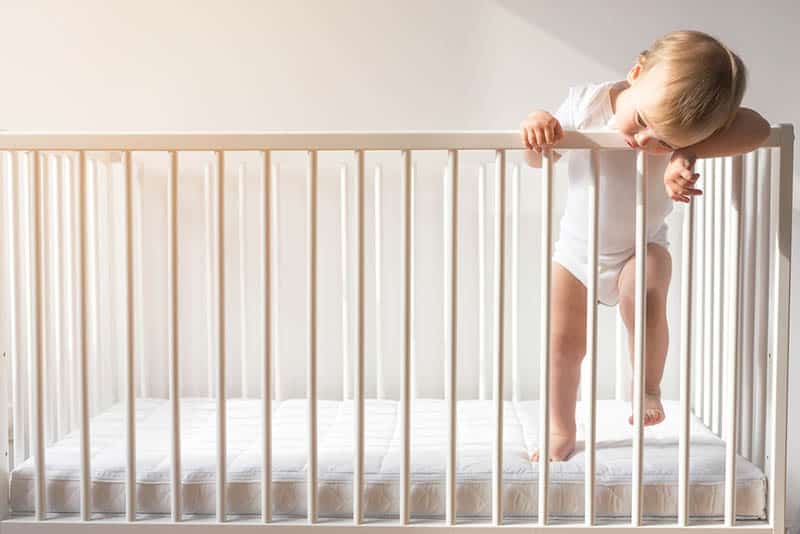
The majority of new cribs are convertible, meaning that they can be turned into a daybed or a full-size bed instead of being thrown or given away after only a few years of use.
The first step is to convert the crib into a toddler bed, which is usually quite simple. Before you get to this part, however, I strongly recommend you check the manual and see whether it’s possible to convert the crib or not.
Turning the crib into a daybed mostly requires lowering the mattress to its lowest position and removing one side rail (the one on the front).
Some cribs have a toddler rail, which is a short panel that protects your little one from rolling over and falling out of bed during sleep.
However, most standard cribs don’t feature this valuable addition, so you’ll have to pay extra in order to get it (assuming the manufacturer sells this type of additional equipment).
When the child reaches the crib weight limits, it’s time to switch to a full-size bed.
The typical length of a convertible crib is 55 inches, while the width of a full-size mattress can be up to 53 inches, which means there shouldn’t be any problems with using the crib during the child’s preschool age.
This part is a bit more complicated, but there’s nothing to be afraid of.
The most important part of converting a toddler bed into a full-sized one is going through the instructions again to check which additional pieces will you need.
This usually includes a full bed frame, because in most cases only one side of the crib is fully usable for the full-sized bed.
Standard cribs usually use standard bolts, but I recommend you check all requirements in the instructions to find out which conversion kits you need.
Since you’re turning a crib into a full bed for an older child, the weight limit will have to be adjusted.
This is possible only by adding stabilizer bars, which will secure the bed frame and increase the maximum weight capacity.
The weight capacity doesn’t depend only on stabilizer bars, but on the type of materials as well.
For example, the best cribs are made out of wood because it is very durable.
However, wooden cribs also have a weight limit from 35 to 50 pounds, even though the real weight capacity is not known.
The same goes for the toddler bed.
What Are Typical Crib Materials?

Cribs are mostly made out of wood or metal because they’re considered to be the strongest materials and can take a lot of weight.
The most common types of wood used for cribs are:
• Ash
• American Beech
• Birch
• Maple
• Oak
• Cherry
• Mahogany
Some manufacturers use pine as well, even though it’s a softwood.
However, pine can hold up to two adults, so it’s more than safe for a baby.
The majority of materials can support a great amount of weight, much more than 50 pounds for sure. Still, a crib has to stay a crib and shouldn’t contain anything but a mattress and a baby.
The weight restrictions ensure that your baby is safe when he’s asleep, especially if the bottom of the crib is covered with plywood without wooden slats.
Plywood can’t take a lot of weight, so if a parent uses anything heavier than the maximum weight capacity set by the manufacturer, the plywood may break down and cause an accident.
Also, even though wood is very durable, it doesn’t mean it’s impervious to damage.
Just like any other material, wood can suffer micro-damage and cracks that may not be visible immediately, but could eventually cause an accident if left unchecked over time.
Wooden cribs are usually protected with an additional coating, however, there are some models that have rough finishes, so make sure to inspect them carefully.
Most cribs don’t have any visible nails or screws to prevent the baby from harming himself by any means.
This is a very important and often underrated aspect of searching for a baby-safe crib.
Some cribs may have a metal frame for a mattress that includes springs, which provides a more comfortable feeling.
Crib mattress frames should always be made out of strong materials such as metal or wood, but should never be made out of plastic that might easily break.
However, that doesn’t mean plastic doesn’t have its own place in the structure of a crib.
This material can be used for teething rails, which are essentially plastic coverings that protect your little one’s teeth while he tries to chew the top of the crib and the side rails.
What Are The Crib Safety Guidelines?
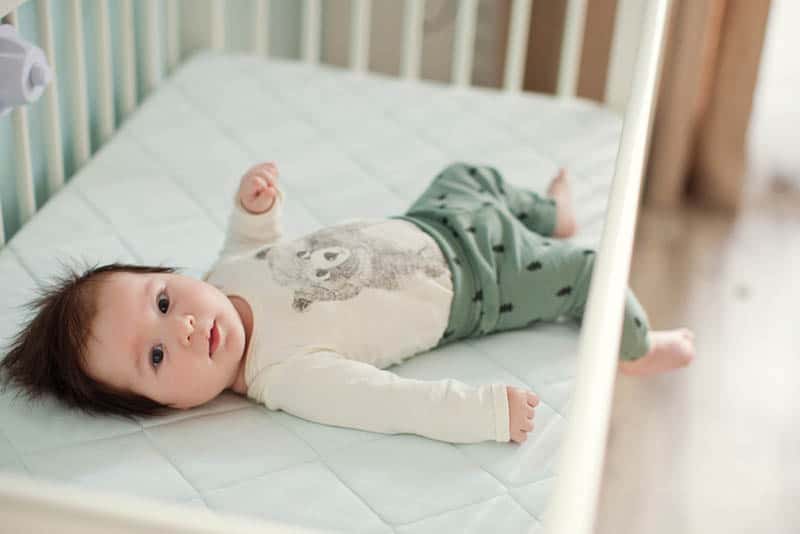
There are very strict guidelines in the United States regarding crib safety measures and restrictions.
These guidelines are made by the US Consumer Product Safety Commission (CPSC) in order to protect your little one from any harm.
Drop-side cribs were very popular in the past because of their convenience and practicality.
However, after numerous incidents, these types of cribs ended up being banned in the US.
General crib restrictions include weight limit and height restrictions, although there are other things that every parent should check before leaving their baby in a crib.
First of all, to be sure that the crib is completely safe for your little one, you need to check the distance between the corner posts and slats.
The maximum distance between the two shouldn’t be bigger than 2 and ⅜ inches, or else your baby’s hand or leg may get stuck between them.
Also, the mattress has to fit the crib without gaps on any crib sides.
When you assemble the crib, try shaking it a few times to check how sturdy it is.
If the crib feels wobbly, check all the parts in case one of them is not tightened enough and go through the instructions again carefully in case you missed something.
If the manufacturer didn’t precisely state there are any spare parts in the set, there should be no leftovers after you assemble the crib.
Also, if you notice some parts are missing (these things do happen quite often), you should check the instructions again or contact the manufacturer for replacements before assembling.
Height restrictions
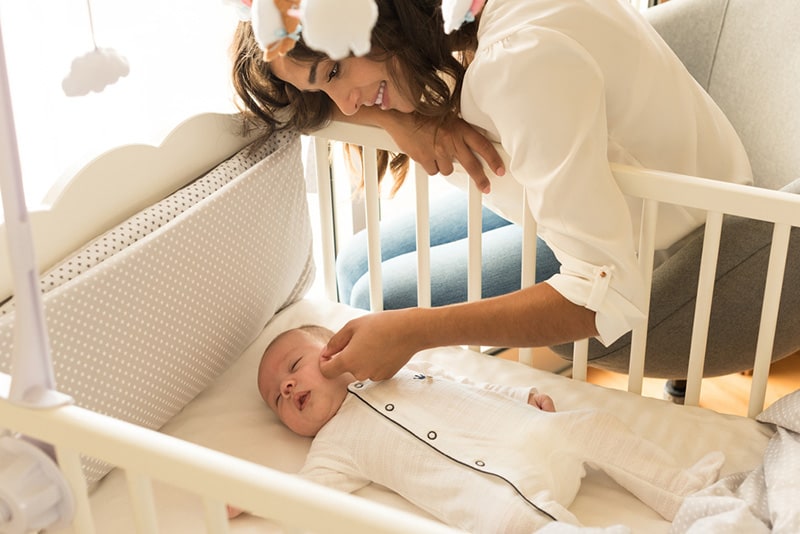
The Height limit is just as heavily regulated as the weight limit when it comes to cribs.
According to guidelines, the crib has to be turned into a toddler bed as soon as your child grows to 35 inches tall.
This regulation is based on the fact that the majority of babies shorter than 35 inches can’t get out by themselves, while those who are taller might easily crawl out in the middle of the night.
More expensive crib models often include multiple mattress positions based on the height of the baby:
• Stage one represents the highest position of the mattress, which is suitable for newborns and infants up to 5 months of age.
• Stage two is usually positioned in the middle and is intended for babies up to 8 months of age who can sit, push, and roll, but can’t stand in a crib.
• Stage three is the lowest setting of the mattress, used before it turns into a bed for toddlers. This stage usually lasts until the baby reaches 35 inches and switches to a toddler bed.
Even though some would describe the transition to a toddler bed as a stage four, I’d rather separate it into a different category as it technically isn’t a crib anymore.
If you notice your baby starting to crawl before he reaches 35 inches, you should convert the crib immediately as he could easily climb out of his crib and hurt himself while doing so.
The minimum distance between the highest and lowest support (including the mattress) should be at least 26 inches.
Standard mattresses are usually somewhere between five to six inches, which leaves around 20 inches of distance between the top of the rail and the mattress itself.
Baby weight measurements
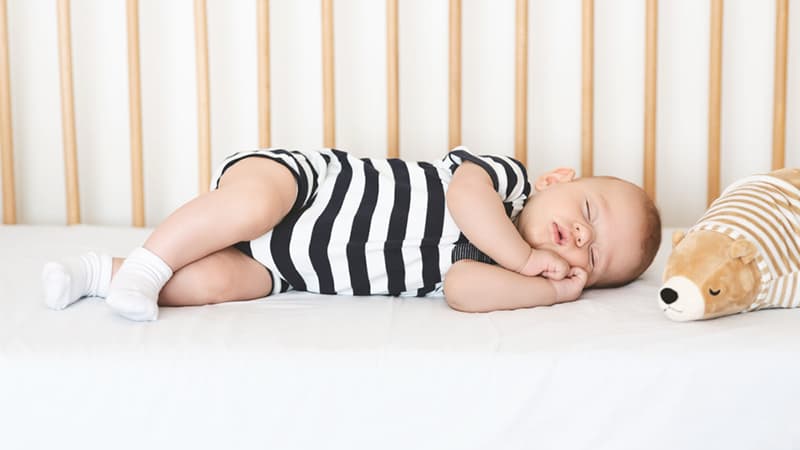
To be honest, I’m really bad at estimating the weight of my children.
Every time I try to guess the weight or height of my kids, I’m miles off reality!
I believe I’m not the only one, so I included this weight chart, which might be as helpful for you as it was for me.
Of course, every baby develops at his own pace, therefore this chart serves only as a guideline to get the general idea of the baby’s weight and height at different stages:
• 12 months old – Around 30 inches and 20 pounds
• 15 months old – Around 31 inches and 22 pounds
• 18 months old – Up to 32.5 inches and 24 pounds
• 21 months old – Up to 33 inches and 26 pounds
• 24 months old – Around 35 inches and 28 pounds
From this chart, it’s clear that most children outgrow the crib in height, so weight shouldn’t be the main factor for crib conversion.
Alternatives For Cribs
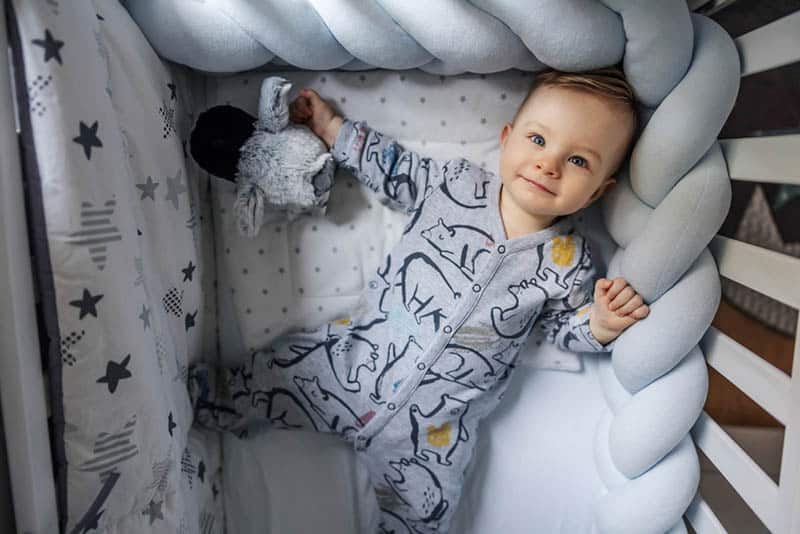
Some parents don’t like cribs as they don’t think they are the best option for their children.
Luckily, there are plenty of alternatives for cribs, like:
1. Floor bed
One of the simplest solutions to avoid a crib, which simply requires a floor and a mattress, is a floor mattress for your little one!
This type of bed doesn’t include height or weight limits, or guidelines.
Although, I would recommend putting a softer mat or a rug down just in case to prevent any accidents.
However, if you do want to use this type of bed, make sure that the baby can’t grab anything dangerous around him and that the room is fully baby-proofed.
2. Bassinets/co-sleepers
A lot of breastfeeding mothers find this option very convenient as they don’t have to get up several times during the night to feed their baby.
Co-sleeping in this way is also the safest form of having your baby close during the night without bed-sharing, although your little one will probably outgrow it by the age of 6 months.
3. Playards
A Playard is a more affordable version of a crib that’s fully portable, which is a great plus as you can take it with you anywhere.
Also, they’re foldable, which is great for people who don’t have a lot of room available.
Another great thing about playards is that your baby can’t get hurt easily when he plays or sleeps as there are no sturdy wooden rails.
It’s also a lot more difficult to climb on the mesh!
4. Bed-sharing
This used to be one of the most common options, but nowadays most parents avoid it out of fear they might accidentally cause harm to their babies during sleep.
It’s definitely the most affordable sleeping option as you won’t need anything except for the bed you already sleep in.
However, some parents simply sleep too hard or require more space while sleeping, while others have too much bedding, especially pillows.
These things might cause SIDS (Sudden Infant Death Syndrome).
Therefore, I’d strongly recommend you learn about all the pros and cons before you make a final decision.
FAQs
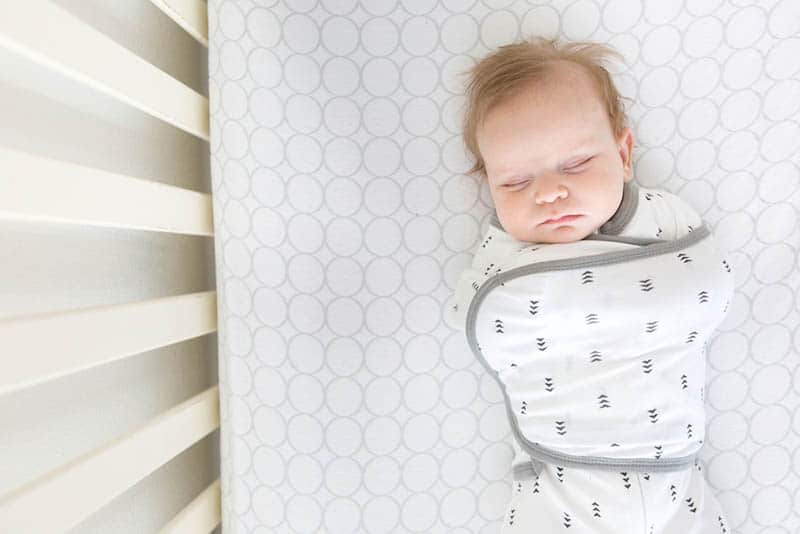
How much weight can a mini crib hold?
As you might’ve already guessed, mini cribs are smaller versions of standard cribs, which means they can hold a lot less weight.
According to the general guidelines, you need to take your baby out of the mini crib when he reaches 22 to 40 pounds (or when he’s tall enough to crawl out from the crib).
Can parents fit in the baby’s crib?
If you think your little one can’t sleep without you, the best thing to do is get a co-sleeper like a bassinet or share your bed with the baby (but be careful if you do this).
Although the maximum weight capacity of a crib is unknown, I wouldn’t suggest you check it by getting in the crib.
The crib could easily break as you enter or end up with tiny cracks that may not be visible right away, but cause problems in the future.
Do older cribs have the same weight limits as modern cribs?
I’ve heard more than once about cribs being passed down from generation to generation, which is a cute idea, but I’m just not sure how safe it is.
The main issue is that most older cribs don’t come with instructions, and even if they do, these regulations are usually outdated and unsafe.
Antique and vintage cribs are surely very precious, especially if they come from past generations of your family, but I’d rather use it as a home decoration than a crib for a child.
However, if you still wish to use an older crib for your munchkin, here’s what you need to pay attention to:
• The mattress has to fully fit in the crib
• It must contain all the pieces
• It’s not a drop side crib
• The slats fit the regulated size
Final Thoughts
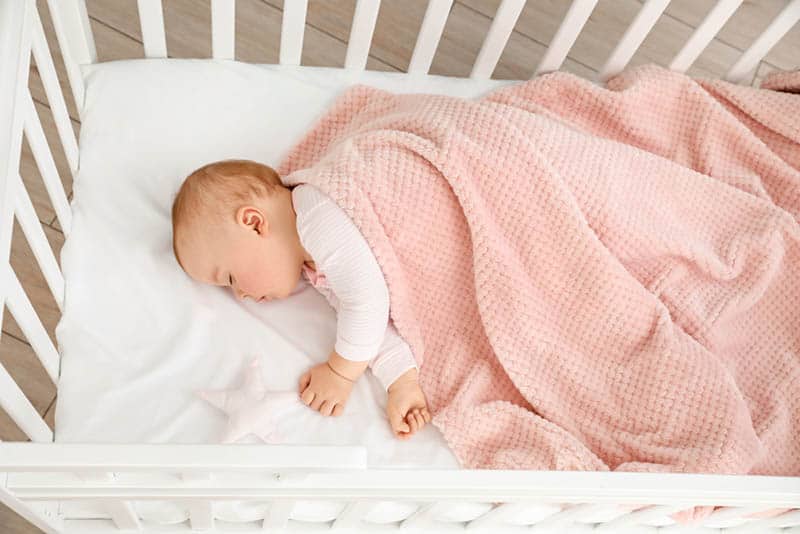
When was the last time you thought: “How much weight can a crib hold?”
Like most parents, I’m sure you haven’t often thought about this question.
However, now that you know all the details about crib standards and regulations, I’m sure you’ll immediately check your child’s crib and follow the guidelines (if you haven’t done so already).
These guidelines aren’t too complicated to follow and they might greatly benefit you.
Why would you buy a bed for toddlers if you could simply turn your crib into one?
If you want your munchkin to be safe during sleep once he outgrows his crib, the best way is to move him from the crib into a bed for toddlers and then into a full-size bed.
I’m sure you’ll make a wise decision, and choose only the best for your little bundle of joy!
Like this post? Please share or pin it for later. You can also stay in the loop and follow us on Facebook, Instagram or Pinterest.
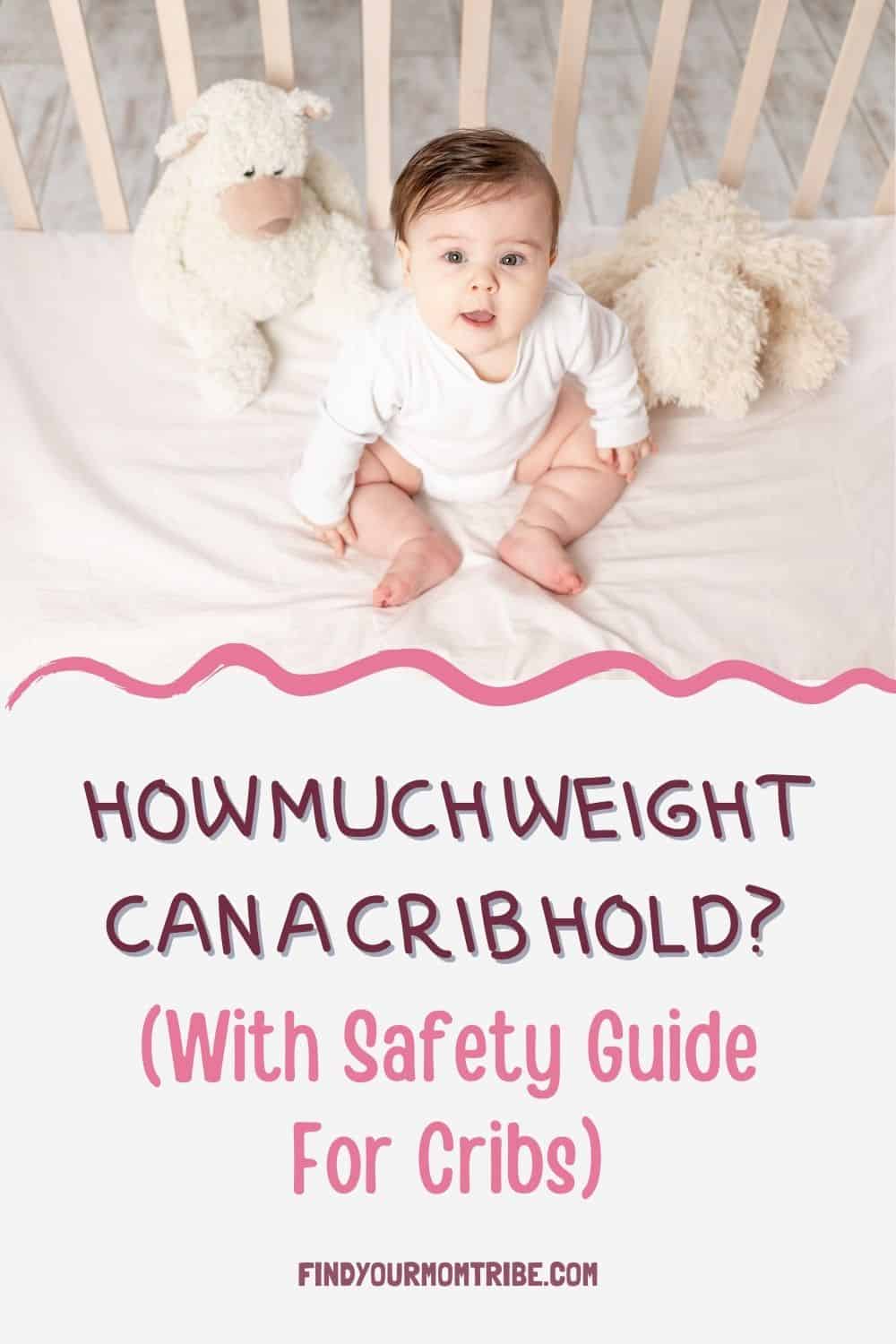
We love honesty! Find Your Mom Tribe is an Amazon Associate and we earn from qualifying purchases through affiliate links at no extra cost to you. Please see our full Amazon Affiliate disclosure for more information.

